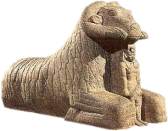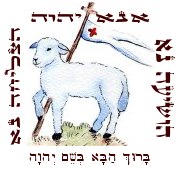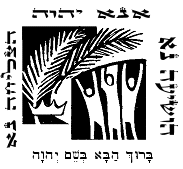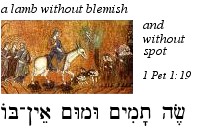|
|
|||||||||||||||||||||
 |
|||||||||||||||||||||
|
Learn Hebrew |
|||||||||||||||||||||
|
|
|
||||||||||||||||||||||||||||||||
 |
|
Origins of Shabbat HaGadol |
|
According to the Talmud, the Exodus from Egypt occurred on Thursday, Nisan 15th, thus making the 10th of that month a Shabbat. It was on this great Shabbat that the LORD commanded the families of Israel to obtain a lamb for sacrifice and to bring it to their homes. This was to be Korban Pesach - the Passover lamb - to be sacrificed on Nisan 14th. |
|
On the tenth of this month (i.e., Nisan) each of them shall take |
|
|
|
When the Egyptian firstborn heard this they begged their fathers to let the Israelites go, but their cries were ignored until a civil war broke out in which many Egyptians were killed (Tosafot Shabbat 87b). This internecine warfare is called the "War of the Firsborn" and is considered a great miracle that helped deliver the Israelites from slavery in Egypt. |
|
Customs of Shabbat HaGadol Jesus' last Passover began some time before the Festival actually began (see John 12:1-33). After visiting his friend Lazarus and his sisters in Bethany, He went to Jerusalem just before the city became filled with pilgrims coming to celebrate the holiday. On the 10th of Nisan He entered the city, riding on a donkey to announce His Messiahship (this was the time the korban Pesach was being selected for the sacrifice). Examined for four days before His sacrifice (execution) for the sins of the world, He was found to be the true Lamb of God (seh haElohim) without spot or blemish. אָנָּא יְהוָה הוֹשִׁיעָה נָּא אָנָּא יְהוָה הַצְלִיחָה נָּא an·na · Adonai · ho·shi·ah · na / an·na · Adonai · hatz·li·cha · na "Please, LORD save us! Please, LORD rescue us! Matthew notes that hoshiah na was addressed to Yeshua Himself, "to the son of David" (לְבֶן־דָּוִד), thereby indicating that the Messianic Hope was presented to Israel (Matt. 21:9). For a flickering moment the proper praise was given to Yeshua as Mashiach ben David, though of course He had come to them as Mashiach ben Yosef, their Suffering Servant, the One to whom the prophet Isaiah clearly foretold.
Upon entering Jerusalem, Yeshua immediately went to the Temple and drove out all who sold there, overturning the tables of the "moneychangers" and the seats of those who sold pigeons (Matt. 21:12). There were actually TWO separate cleansings of the Temple recorded in the New Testament. The earlier cleansing is described in John 2:13-22 and the later one is described in (both) Mark 11:15-19 and Matthew 21:1-16. In Mark's account of the second cleansing, Yeshua actually stopped the "carrying of the ritual vessels" -- meaning He LITERALLY stopped the sacrifices of Israel. Mark 11:16 states: "And he would not suffer that any man should carry any vessel through the Temple." Despite performing miraculous works of healing in the Temple that day -- including opening the eyes of the blind and causing the disabled to walk -- the kohanim (chief priests) and soferim (scribes) were "indignant" at His actions and therefore sought to put Him to death (Mark 11:18). "O Jerusalem, Jerusalem, the city that kills the prophets and stones those who are sent to it! How often would I have gathered your children together as a hen gathers her brood under her wings, and you would not! See, your house is left to you desolate. For I tell you, you will not see me again, until you say, 'Blessed is he who comes in the name of the Lord.'" And Jesus went out, and departed from the Temple (Matt. 23:37-24:1). In Matthew 24 Yeshua's disciples made a last-ditch appeal for Jewish tradition and ceremony by pointing out the glory of the Second Temple. "Look at these beautiful buildings of the Temple, Lord..." It was then that Yeshua pronounced judgment on the Temple and the entire Levitical sacrificial system, predicted the destruction of the Temple by Rome, and so on. This was apparently unfathomable to the disciples, who apparently still considered Yeshua to be a "reformer" of Temple Judaism, perhaps the one who would restore it so that the Kingdom of God would be finally manifest upon the earth. Yeshua went on to explain the signs of the End of the Age (אַחֲרִית הַיָּמִים) that would precede the promised Days of Messiah (יְמֵי הַמָּשִׁיחַ), otherwise known as the Messianic Kingdom. He foretold that one day praise would rightly be given to Him as Israel's True King, but only after the travail of the coming Great Tribulation upon the earth. Only after the Jewish people cry out to Him as their LORD (Matt. 23:39) would the Kingdom of God be established in Zion. A Note about the Jewish Hour (sha'ah) The Cross of Yeshua is the true Holy of Holies where God Himself offered His Son as the Lamb of God who takes away the sins of the world... It is there that He made agonizing intercession for us -- the Just for the unjust -- so that we are spared from God's wrath and eternally reconciled to Him. Just as the original Passover foreshadowed God's deliverance of His people from Egypt and slavery, so the Passover of Yeshua represents God's deliverance of us all from the power and slavery to sin. Yeshua had foretold that one day the praise will be rightly given to Him as Israel's true King, but only after the travail of the coming Great Tribulation upon the earth, when the Jewish people will cry out to Him and all Israel shall be saved (Matt. 23:39). However, through His propitiatory death -- the Just for the unjust -- and our faith in His love for us, we are ascribed righteous standing before God Himself (2 Cor. 5:21). During this Passover season, let us all join the chorus and say, "Blessed is He (Yeshua) who comes in the Name of the LORD!" (בָּרוּךְ הַבָּא בְּשֵׁם יְהוָה). Amen. Rabbi Yehoshua says: "In Nissan the world was created ... the bondage of our ancestors ceased in Egypt; and in Nissan they will be redeemed in time to come." (Talmud Rosh HaShana 11a) The prophetic reading ends with: הִנֵּה אָנכִי שׁלֵחַ לָכֶם אֵת אֵלִיָּה הַנָּבִיא hin·nei · a·no·khi · sho·le·ach · la·khem · et · E·li·yah · ha·na·vi "Behold I will send you Elijah the prophet |
|
Like most prophecies in the Tanakh, this one is "dual-aspect." First, John the Baptist was identified by the Mashiach as the "Elijah who is to come" (Matt 11:14). John prepared the way for the ministry of the Mashiach, and he turned the hearts of many Jews back to God through his preaching of repentance. Therefore the spirit of Elijah did indeed come and herald the day of the LORD - however, this is the "day of the salvation of our God," and therefore marks the time of grace where mankind can return to God and be redeemed by the blood of the Lamb of God. |
|||
|
Review Questions: Shabbat HaGadol |
|||
|
When is Shabbat HaGadol? |
|||
|
|
|
Why is this Shabbat considered "gadol?" |
|
|
|
What customs are associated with Shabbat HaGadol? |
|
|
|
Prophetic Significance? |
|
|
|
|
|
|
Hebrew for Christians |
|||||
|
|||||





